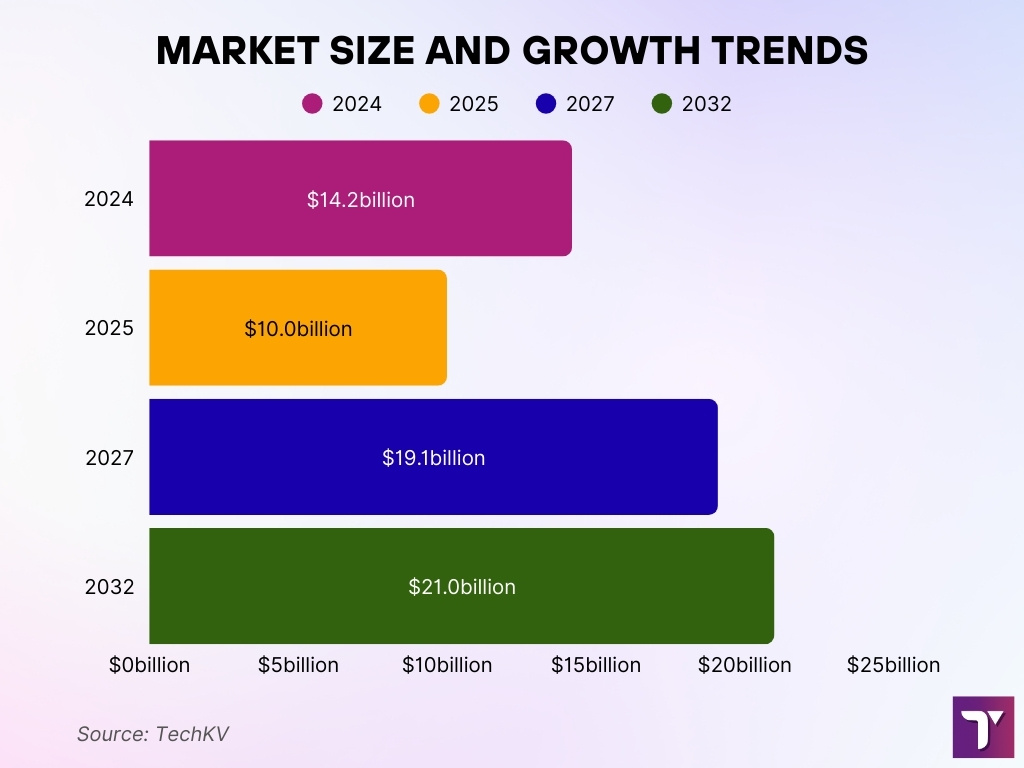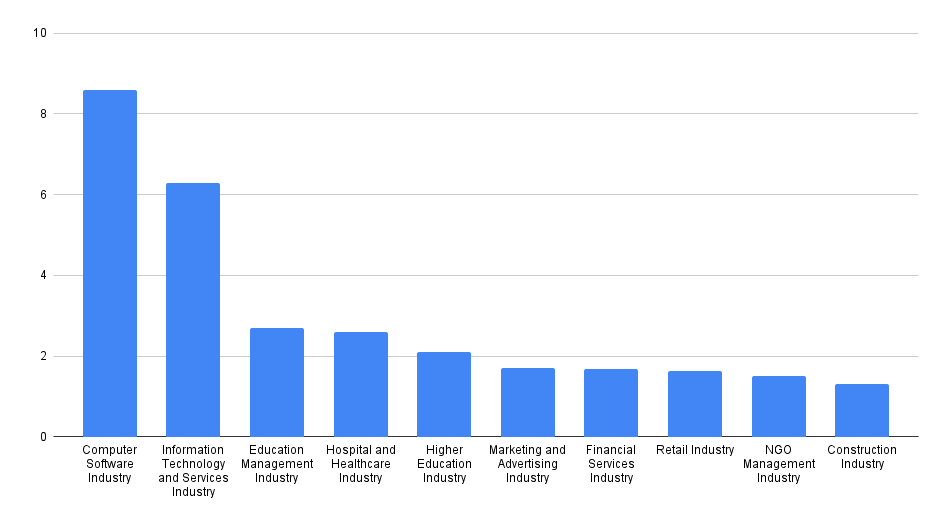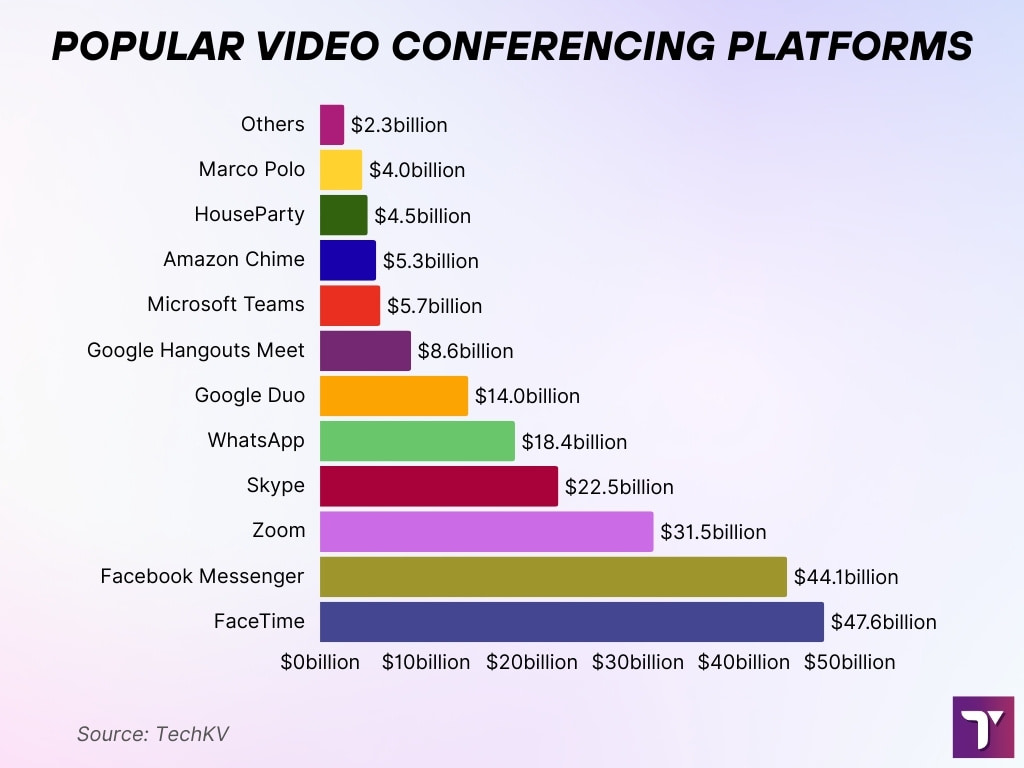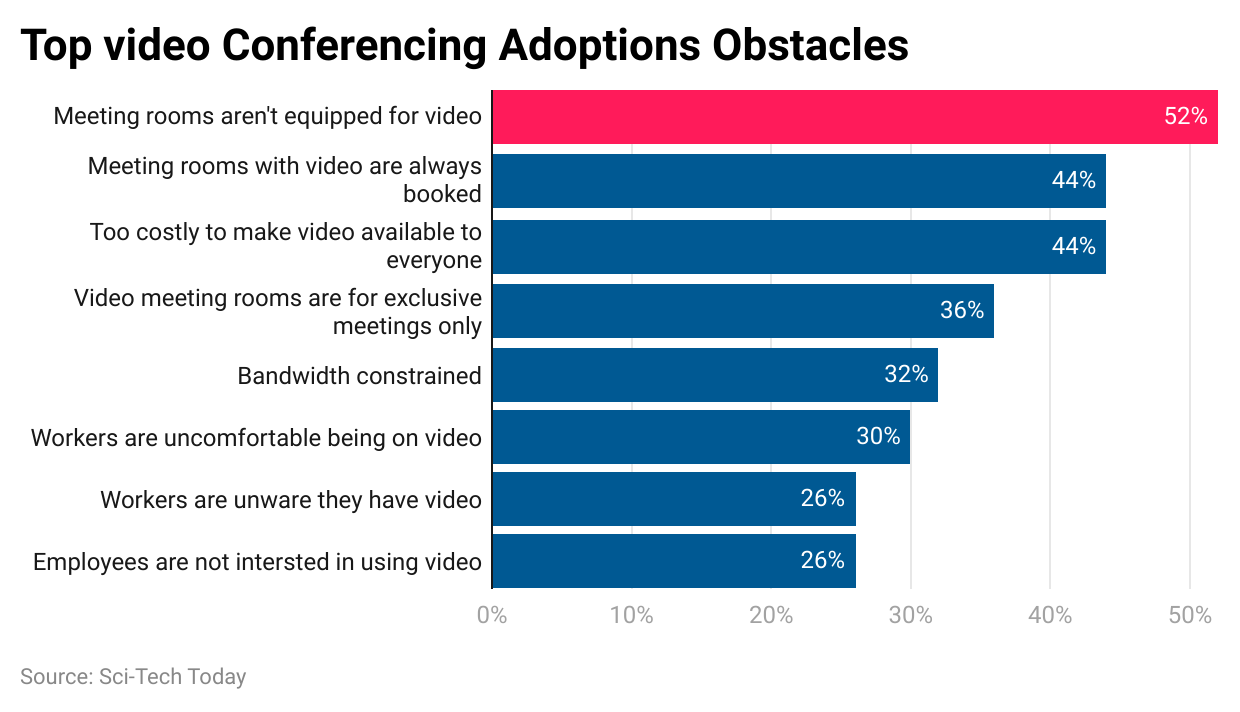Video conferencing has become a central part of how businesses, educators, and individuals connect efficiently, visibly, and in real time. From global boardrooms to virtual classrooms, platforms like Zoom and Teams create seamless interactions across distances. In healthcare and remote work, for instance, teleconsultations and hybrid meetings boost productivity and access. With that in mind, let’s explore key statistics driving the video conferencing landscape.
Editor’s Choice
- The global video conferencing market hit around $14.2 billion in 2024, showing strong momentum heading into 2025.
- Zoom holds a commanding 55.91% of the global market share and serves 300 million daily users.
- Microsoft Teams follows close behind with 32.29% market share and 280 million daily users.
- North America accounted for $5.9 billion in video conferencing revenue, the largest regional share.
- Paid subscriptions doubled from 2020 to 89 million in 2025.
- 65% of corporate events now occur via video conferencing platforms, up from 40% in 2020.
- Zoom raised its full-year 2025 revenue forecast to $4.61–$4.66 billion, backed by strong demand and AI adoption.
Recent Developments
- In 2025, video conferencing platforms will increasingly integrate AI features, like real-time transcription and virtual assistants, to streamline meetings.
- Zoom launched Zoom Workplace, its AI-powered collaboration platform, enhancing hybrid work capabilities. It also widened AI tools for paid users.
- Video conferencing vendors are embedding hardware, software integration to support hybrid offices, pushing innovation beyond purely digital tools.
- Platforms continue to enhance security and expand reach. Cisco Webex increased coverage of Webex Calling into over 65 countries, supporting global enterprise communication.
Market Size & Growth Trends
- The global video conferencing market reached approximately $14.2 billion in 2024, and growth continues into 2025.
- Projections estimate the market will reach $10 billion in 2025, rising to $21 billion by 2032, reflecting an 11.8% CAGR.
- Forecasts vary; some estimate $14.4 billion by 2024, growing to $19.1 billion by 2027.
- North America remains the largest regional market, contributing $5.9 billion, followed by Europe’s $3.1 billion.
- The enterprise segment generates over 50% of total sales in the video conferencing market.
- Consumer platforms account for roughly 39% of revenue, while business-focused tools make up 61%.

Platform Market Share & Usage
- Zoom leads with 55.91% of the global video conferencing software market.
- Microsoft Teams holds 32.29%, securing the second spot.
- Other platforms include Cisco Webex at 11%, Google Meet ~5–5.5%, and Skype around 1.4%.
- In the U.S., Zoom commands ~60% of the online video conferencing market.
Zoom Usage Statistics
- Zoom reports about 300 million daily active users globally.
- In 2024, Zoom’s annual revenue was $4.66 billion.
- Forecasts for 2025 revenue climbed to $4.61–$4.66 billion, driven by hybrid work trends and AI enhancements.
- Zoom logged over 3.3 trillion meeting minutes in the most recent data.
- Business customers number around 504,900 globally.
- In the U.S., Zoom’s market share stands at about 60%.
Microsoft Teams Usage Statistics
- Microsoft Teams controls 32.29% of the global market share.
- An estimated 280 million daily active users rely on Teams for communication.
- Its deep integration with Microsoft 365 tools, like document sharing, chat, and task management, has strengthened its position, especially internally.
Cisco Webex Usage Statistics
- Cisco Webex holds about 11% of the video conferencing market share in 2025.
- The U.S leads in Webex usage, followed by the UK, Germany, Canada, India, Australia, and France.
- Webex Calling now extends to over 65 countries, broadening its enterprise communication reach.
Skype Usage Statistics
- In 2024, Skype users made 3 billion minutes of video calls daily.
- By then, Skype had around 300 million monthly active users and over 40 million daily users.
- On average, Skype facilitated 2 billion minutes of voice and video calls per day.
- Approximately 89% of remote workers considered Skype or similar platforms essential for staying connected.
- Skype was officially retired on May 5, 2025, with users transitioning to Microsoft Teams.
- Before its retirement, Skype still maintained notable usage, around 300 million MAUs and 40 million DAUs.
- Skype for Business was used by over 70% of Fortune 500 companies, reflecting strong enterprise adoption.
- Its decline in 2025 highlights a broader shift toward integrated platforms like Teams.
Industry Distribution Insights
- The Computer Software Industry leads significantly with a value of 8.6, making it the most represented sector.
- The Information Technology and Services Industry follows at 6.3, showing its strong presence in the landscape.
- The Education Management Industry and the Hospital and Healthcare Industry hold mid-level positions, scoring 2.7 and 2.6, respectively.
- The Higher Education Industry comes next with a value of 2.1, highlighting its moderate contribution.
- Marketing and Advertising, Financial Services, and Retail Industries are tied with 1.7 each, showing a smaller but still notable representation.
- The NGO Management Industry records 1.5, slightly below the mid-tier industries.
- The Construction Industry stands last with a value of 1.3, marking it as the least represented among the listed sectors.

Webinar and Online Training Statistics
- Webinars in 2025 continue to convert strongly, with an average conversion rate of 56% and attendance between 35% and 45%.
- Nearly 85% of marketers now view webinars as essential, and 98% plan to integrate AI into their webinar strategy.
- The ideal webinar length remains between 30 and 45 minutes, and most registrations occur within one week of the event.
- In education, 88% of educators believe video-based platforms, especially webinars, help more students complete advanced degrees.
- Students retain 60% more information through online learning compared to traditional classrooms.
- Virtual classroom training and webcasts accounted for 39% of training delivery methods in large companies in 2024.
- Among midsize and small firms, 84% and 70% respectively, adopted video-based training tools in 2024.
User Adoption & Usage Behavior
- 58% of companies now use video conferencing in their day-to-day operations.
- Among larger companies, 83% intend to purchase collaboration tools, compared to 27.6% of small businesses.
- In 2025, around 22% of the U.S. workforce, or 32.6 million Americans, work remotely, up significantly from 6.5% in 2019.
- Globally, 83% of employees prefer hybrid models that blend home and office work.
- 81% of employees rate remote work as more important than salary, and 46% would quit if the options were dissolved.
- 42% of users attended a video meeting lasting more than one hour in the past month.
- Sales teams report that 57% make 3-5 video calls per day, while only 23% of marketers match that frequency.
- Teams of fewer than 10 hold about 2.1 video calls daily, whereas teams of 50+ average 4.8 calls.
Productivity & Business Impact
- 79% of workers say video conferencing is as effective as in-person meetings, and many find it more productive.
- 94% of HR leaders believe video conferencing boosts productivity in remote work contexts.
- In 2022, the market penetration of conferencing tools increased by 65%, indicating widespread business adoption.
- The biggest challenge is technical issues, reported by 58% of professionals during video calls.
- Despite hurdles, 99% of employees said video conferencing improved their communication experience.
- However, over half of British professionals report that virtual meetings interrupt productivity, with 25% enduring 5+ online meetings daily.
Regional Adoption Trends
- North America commands approximately 30.96% of the global video conferencing market share in 2024.
- The U.S. video conferencing market is projected to grow to $11.3 billion by 2032.
- In 2024, North America’s market was valued at $14.11 billion, rising to an estimated $15.56 billion in 2025, with a 10.25% CAGR through 2033.
- The Asia-Pacific region is expected to see the fastest CAGR (over 9%) from 2025 to 2033, driven by SMEs, startups, and digital infrastructure expansion.
- Latin America’s video conferencing adoption grew 29% in the past year, compared to 18% in Europe and 15% in North America.
- Zoom led usage in 80 countries as of 2025, while Microsoft Teams led in 41 countries.
- RingCentral and Google Meet held 5.67% and 5.32% of the market share, respectively, in 2025.
- Adobe Systems also captured a notable 18% share of the video conferencing market in 2025.
Device & Platform Preferences
- Roughly 77% of respondents use a laptop or desktop for video calls, versus mobile or tablet devices.
- Among employees aged 18-34, 78% prefer video conferencing over phone calls, though only 49% of users over 50 feel the same.
- Zoom, for example, sees 29.71% of its users aged 25–34, and 21.46% aged 35–44, with a virtually even female–male split (50.1% vs. 49.9%).
- Zoom’s top revenue-generating countries include the U.S., Japan, India, Canada, and the U.K., which also account for over 50% of its user base.
- The global video conferencing devices market is valued at approximately $15 billion in 2025, with a strong 12% CAGR through 2033.
- Most meetings rely on traditional computing devices, reflecting a preference for larger screens and stable setups.
Key Insights on Popular Video Conferencing Platforms During the Pandemic
- FaceTime emerged as the most used platform with 47.6% usage.
- Facebook Messenger closely followed with a strong 44.1% share.
- Zoom, the leading choice for professional meetings, captured 31.5% usage.
- Skype, once a dominant player, still maintained a significant 22.5% share.
- WhatsApp proved popular for casual video calls with 18.4% adoption.
- Google Duo achieved 14.0% usage, showing a strong presence among mobile users.
- Google Hangouts Meet was used by 8.6%, reflecting its role in workplaces and education.
- Microsoft Teams had 5.7% usage, notable in enterprise and organizational settings.
- Amazon Chime registered 5.3%, indicating relatively limited adoption.
- HouseParty, popular among younger demographics, accounted for 4.5%.
- Marco Polo saw 4.0% usage during the pandemic.
- Others combined made up 2.3%, showing minimal adoption compared to major platforms.

Hybrid Work & Video Conferencing Integration
- Globally, 82% of company leaders plan to continue remote or hybrid work models beyond the pandemic era.
- Among midsize businesses, 75% are shifting to hybrid operations with employees splitting time between office and remote locations.
- In the U.S., more than 32.6 million Americans (about 22% of the workforce) are expected to work remotely by 2025.
- Remote work remains crucial; 81% of employees say it’s more important than salary, while 46% would quit if the option disappeared.
- Remote workers report reducing greenhouse gas emissions by up to 54% when working fully from home for a week.
Industry Adoption Statistics
- 89% of companies now use multiple video conferencing platforms simultaneously to meet diverse needs.
- 86% of companies conduct interviews online, with 66% of candidates preferring video conferencing over other formats.
- Businesses save around $11,000 per employee annually by adopting video conferencing and reducing travel costs by up to 30%.
- Poorly organized meetings cost businesses $399 billion annually, while unproductive meetings cost $34 billion.
- Cisco Webex reported 650 million monthly meeting participants in 2025.
- Enterprise video conferencing generated $3.64 billion in 2022, with consumer applications earning $3.36 billion.
Demographics of Video Conferencing Users
- Zoom’s user base is dominated by the 25–34 age group (29.9%), followed by 35–44 (21.67%).
- Gender balance is nearly even on Zoom, 50.1% female, 49.9% male users.
- Over half of first-time users say their initial video call was for personal, not professional reasons.
- Zoom’s website logged 11.2 million visits (mobile + desktop) in June 2024 alone.
Cost Savings and Business Impact
- Video conferencing saves $11,000 per employee annually through reduced travel and increased efficiency.
- Organizations curb travel costs by up to 30% via virtual meetings.
- Poorly managed meetings result in $399 billion in losses annually, and unproductive ones contribute $34 billion in wasted resources.
- Rapid decision-making improves 87% of team members report faster outcomes with video calls.
- Online hiring is widespread; 86% of companies conduct interviews via video, with 66% of candidates preferring it.
Innovation & Technology Trends
- AI, real-time translation, and enhanced collaboration tools continue to expand adoption across platforms.
- Zoom sold over 4 million Zoom Phone units globally by Q2 2025.
- Telehealth applications are booming; the telehealth video conferencing sector alone is expected to approach $923 million by 2025.
- Video conferencing tools are increasingly supporting multiple languages, live captioning, and translation features.
Security and Privacy Statistics
- 58% of professionals cite technical or software issues as the biggest challenge during video calls.
- 49% of employees feel more fatigued after virtual meetings, and 37% report Zoom fatigue, particularly among women and introverts.
- Privacy intrusion is a concern; home environments can expose personal surroundings during meetings, causing discomfort among users.
- Some tools continue monitoring audio even when a user is muted; research found it possible to infer users’ background activities with 81.9% accuracy.
- The phenomenon known as Zoombombing remains a notable threat; video platforms continue strengthening default security settings to counter it.
- Critics have questioned Zoom’s encryption transparency and data-sharing policies, noting discrepancies between claims of end-to-end encryption and actual implementation.
Challenges & Limitations
- Zoom fatigue, mental exhaustion from excessive video calls, is a widespread issue in 2025.
- Remote workers often struggle with poor work-life boundaries, particularly when meetings intrude into personal spaces.
- Collaboration hurdles and loneliness are reported by 16% of remote workers, with 15% citing home distractions and 12% finding motivation tough.
- Unsent requests to mute webcams or microphone use persist, despite discomfort and privacy concerns.
- Isolation and unclear career progression continue to challenge remote professionals. Early research suggests that social isolation can reduce motivation and hinder recognition.
Key Obstacles to Video Conferencing Adoption
- 52% of organizations report that meeting rooms aren’t equipped for video, making it the biggest barrier.
- 44% say meeting rooms with video are always booked, limiting accessibility.
- Another 44% cite that it is too costly to make video available to everyone.
- 36% mention that video meeting rooms are reserved for exclusive meetings only, restricting broader use.
- 32% face bandwidth constraints, affecting video quality and reliability.
- 30% of workers feel uncomfortable being on video, pointing to cultural or personal barriers.
- 26% of employees are unaware they have video access, showing a communication gap.
- Another 26% are simply not interested in using video, reflecting a lack of adoption willingness.

Employee Sentiment & Remote Experience
- 79% of workers agree that remote meetings are as effective or more effective than in-person sessions.
- 70% of remote workers say virtual meetings are less stressful, and 71% find it easier to present in this format.
- 96% report that video conferencing boosts connectivity across remote teams.
- More than 54% of employees regularly attend work-related virtual meetings, though 23% feel uncomfortable, and 75% prefer audio-only calls.
Future Outlook
- The global video conferencing market is projected to expand from $37.29 billion in 2025 to $60.17 billion by 2032, with a 7.1% CAGR.
- In the U.S., the market is forecasted to grow from $10.8 billion in 2024 to $26.14 billion by 2030, with a 15.7% CAGR.
- Device-focused markets also grow; hardware adoption is expected to rise steadily with at least a 12% CAGR through 2033.
- Expect broader AI integration, smarter collaboration tools, and enhanced privacy and security features across platforms.
Conclusion
Video conferencing has fundamentally reshaped modern communication, from work to learning to healthcare. It delivers significant cost savings, operational efficiency, and widespread adoption across demographics and regions. Yet, challenges remain, including security vulnerabilities, meeting fatigue, and privacy concerns, especially for remote workers. As technology evolves, companies must continue refining tools and best practices to nurture user trust and productivity. Looking ahead, robust AI enhancements, smarter device integration, and stronger security will guide the next wave of growth and innovation in this vibrant sector.
